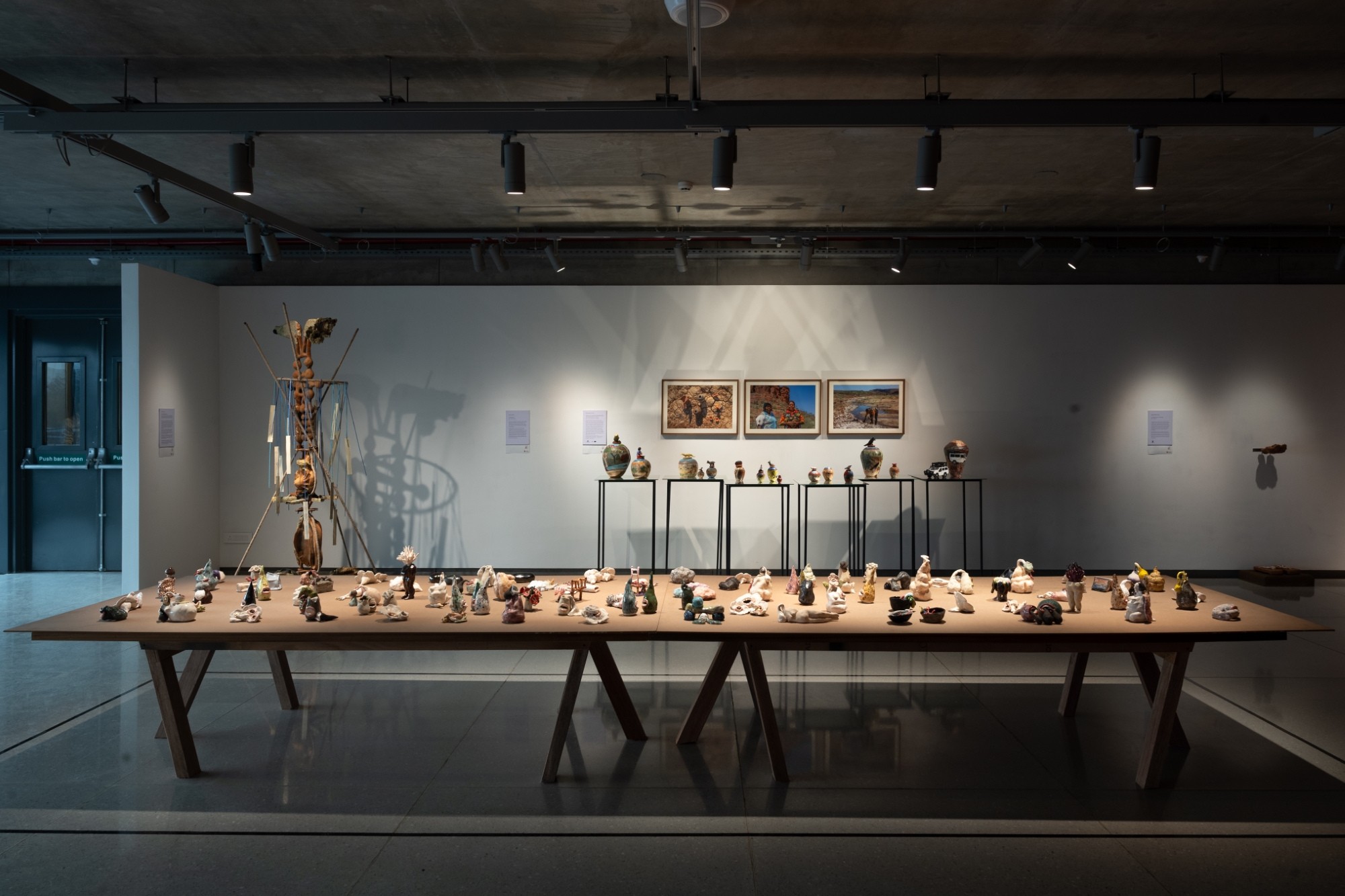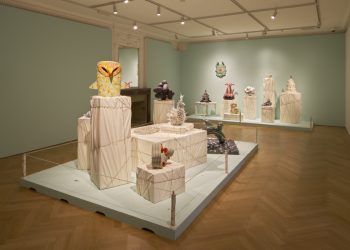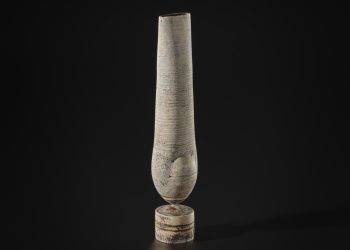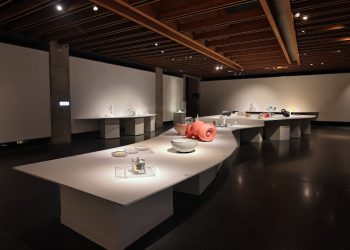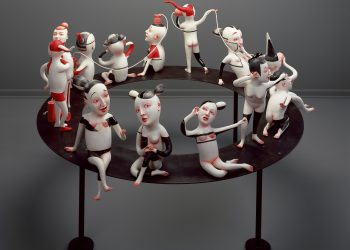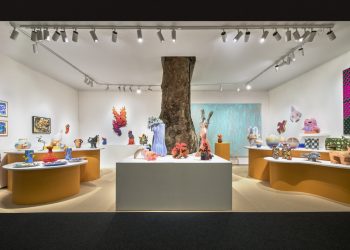The over two-month-long Indian Ceramics Triennale features a showcase of over 60 Indian and international artists from 12 countries unveiling 34 projects as a celebration of diversity in contemporary ceramics.
Engaging with landscapes, identities, and histories embedded in clay, Common Ground aims for greater inclusivity, reflecting on practices that mediate between readings of precedent and practice, historical and contemporary, material and ephemeral. After its successful inaugural edition in Jaipur in 2018, the second iteration of the Indian Ceramics Triennale, themed ‘Common Ground,’ is on view through March 31, 2024, at New Delhi’s newest cultural hub, Arthshila.
Seeking to create a dialogue between varied pasts and presents, and between materials and methodology, technology and tradition, Common Ground showcases these dynamic and fluid conversations through the artistic lens of renowned ceramic artists from South Asia and around the world, including Eliza Au from the USA, Rita Badilla-Gudino from the Philippines, and Indian artists such as Parag Tandel, Deepak Kumar, Ankon Mitra, Dhruvi Acharya, and more.
The theme of “Common Ground” builds upon the framework of Breaking Ground from the first edition, aiming to nurture the diversity of ceramic art expression. This Triennale serves as a platform for showcasing clay-centric projects that transcend boundaries and challenge expectations.
The Triennale’s inclusive programming, from symposium sessions and artist demonstrations to curated films and engaging workshops, invites audiences to immerse themselves into the expansive world of contemporary ceramics.
The full programme and the complete list of participating artists are available on the triennale’s website. https://www.indianceramicstriennale.com
Selection from the 2024 Indian Ceramics Triennale
Andrew Burton & Lilian Nabulime: Revisioning Bithooras
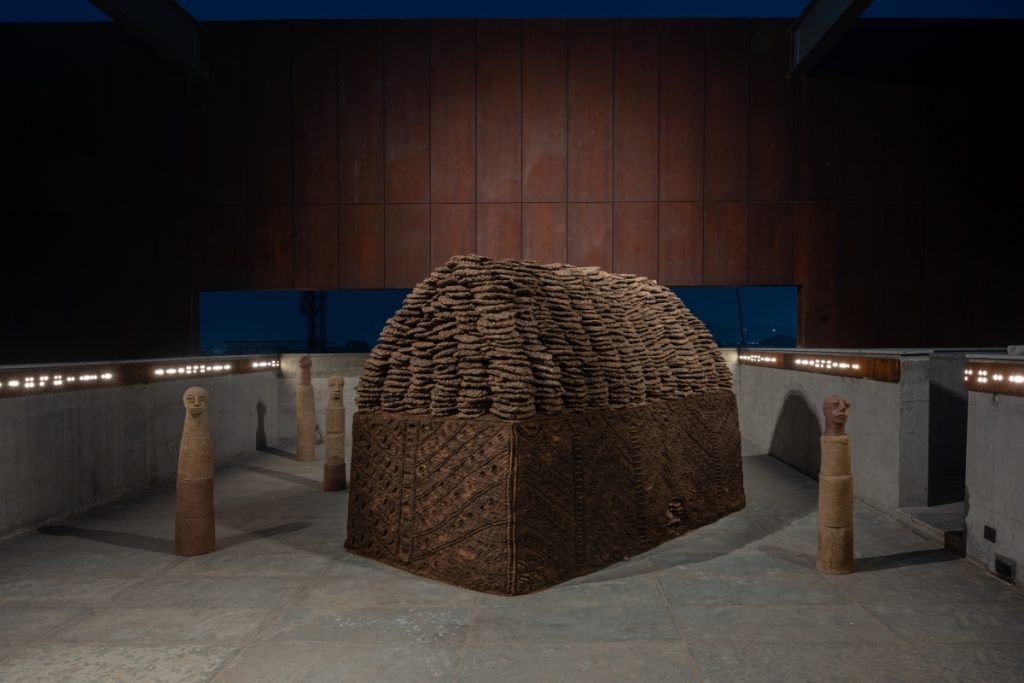
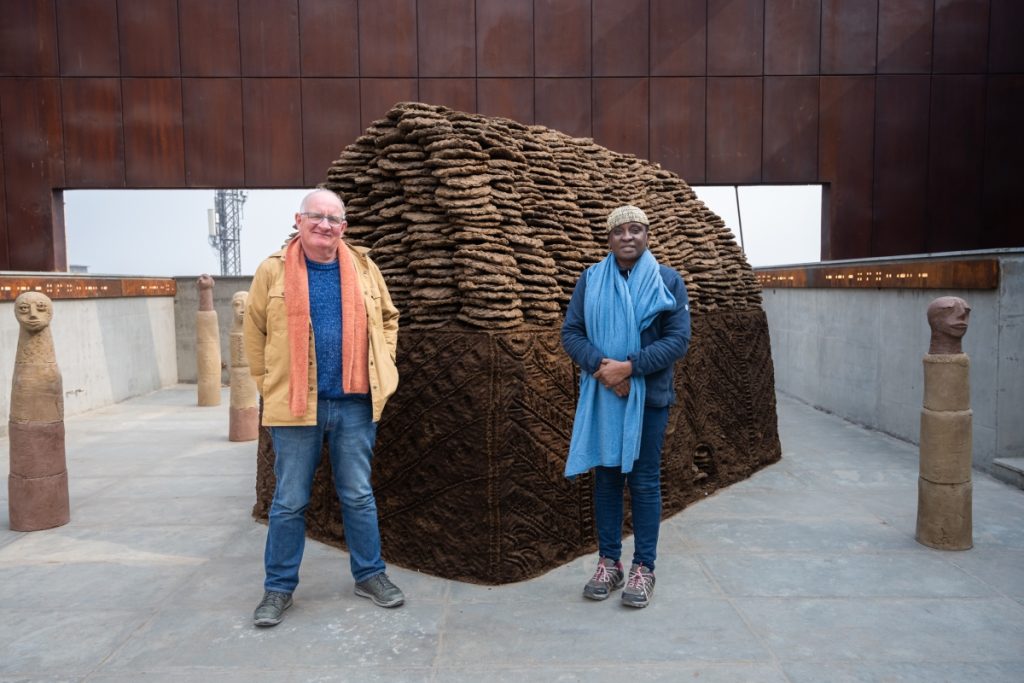
Revisioning Bithooras celebrates bithooras, an extraordinary but overlooked feature of Delhi’s cityscape and cultural heritage. These elaborately decorated fuel stores are made entirely from cow dung. Unique intrusions of the rural within the city, bithooras are built slowly, only to be broken down to retrieve the uplas which are used for fuel.
This project focuses attention on these astonishing objects, and explores them in the context of contemporary art. Here, bithooras are reimagined through an artistic interaction between Lilian Nabulime from Uganda, British artist Andrew Burton and the bithoora makers – women from dairy farming communities around Delhi. Revisioning Bithooras explores how the juxtaposition of ‘earth’ and ‘clay’ elements and the relationship between architectural, functional and figurative form can have meaning and resonance in Delhi in 2024.
LILIAN NABULIME is a leading Kampala-based artist known for her wood carving and for her social sculpture tackling stigma around HIV AIDS. ANDREW BURTON is a British artist whose work explores themes of architecture, nature and heritage.
Nabulime and Burton have collaborated since 2015 on projects in Africa exploring ‘jua kali’ (which translates as under the sun), focussing on marginalised artisanal work. They have each shown their work internationally for over twenty years, winning many prestigious prizes and awards. For the Indian Ceramics Triennale, they will be collaborating with women from dairy farming communities around Mandi Village South Delhi who are experienced bithoora makers.
Ankon Mitra & Revati Jayakrishnan: From Point, Line and Triangles – to the Cosmos
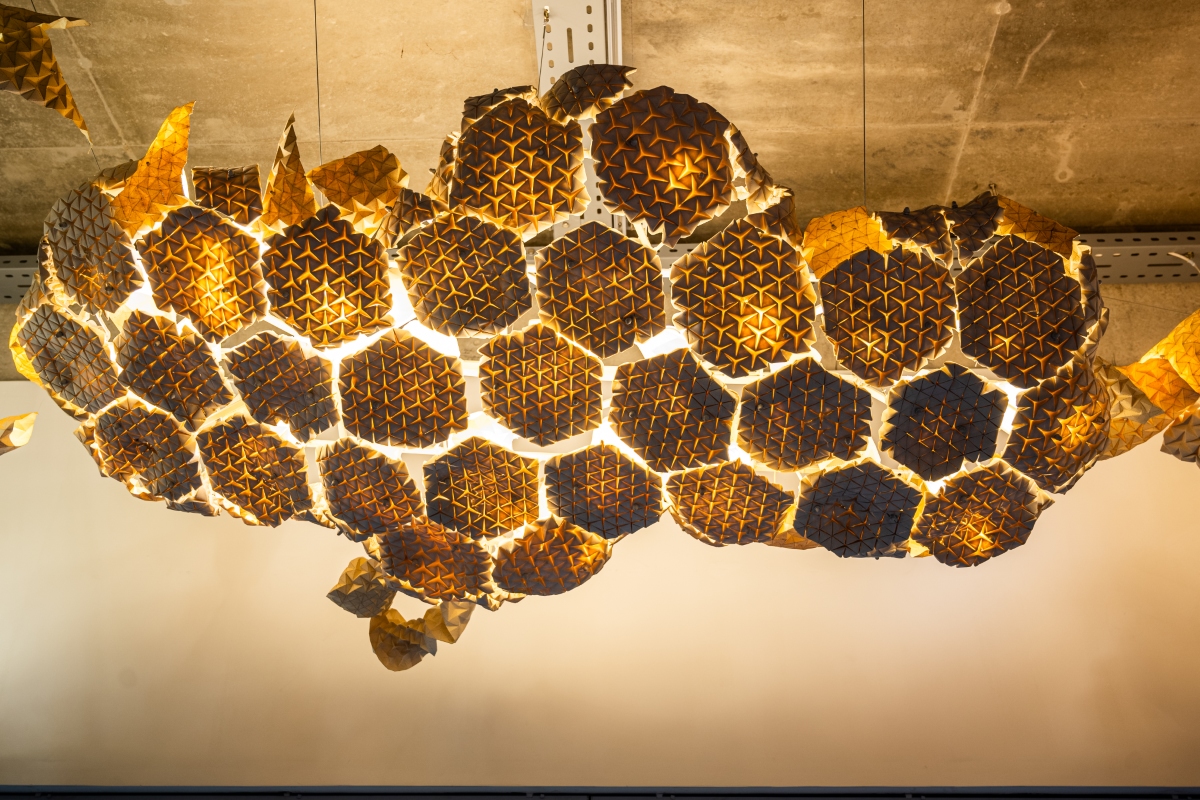
Earth, an infinitesimal,
speck of dust in the cosmos.
You and I, feeling
amorphous, labouring, from
the clay of this Earth.
Dust and water, mixed together.
Forever pulled by gravity,
pummelled and tread underfoot.
Dark, dank with the
sweet petrichor of Karma,
the unbearable heaviness
of being.
To imagine…
the vastness,
the lightness,
the infinite,
that WE are.
The amorphous earth
transformed with precision,
rolled out thinnest
to breaking point,
from that point to line,
and from that line to triangles,
verily triangles…to cosmos.
In the spiritual
kiln of release,
the smooth and supple
heaviness,
It burns,
and cracks open.
The beauty of the façade
disappears,
A glorious lightness,
an innermost radiance.
It takes a million cracks
and a billion triangles,
to escape the
amorphous heaviness.
Earth no longer
tread underfoot.
But flying in the air.
Not like specks of dust
off parched Earth
picked up by a hot summer wind.
But like the billowing
fiery cosmic storm itself,
that builds trillions
of Suns and Earths.
ANKON MITRA is an architect and internationally acclaimed artist of the technique of folds. He is the recipient of the All-India Gold Medal for Sculpture in 2018 and the Lexus Design Award for Craft Design in 2020. His folding studio is Oritecture = Ori (folds) + Architecture. He firmly believes the Universe is made and unmade from acts of folding. An alumnus (magna cum laude) of the Bartlett, University College London, his work has been exhibited in 15 countries and his sculptures and installations are part of prestigious collections (public and private) all over the world. His most recent exhibitions were at the Arte Laguna Prize, Venice, Art in Odd Places, New York and the Shanghai Paper Art Biennale.
REVATI JAYAKRISHNAN is an artist, designer, maker and educator. A graduate of IICD, Jaipur with an MA in Contemporary Crafts from UCA, Farnham, UK, she runs Rare Studios – a practice specializing in ceramics and glass. Her work is part of the Sanskriti Museum, New Delhi and has been exhibited at the London Design Festival (2014) and the Kala Ghoda Arts Festival (2016). A recipient of NCECA’s Multicultural Fellowship (2016), she presented her research at the 2023 NCECA conference in the USA. She is currently Assistant Professor at the School of Creativity, Rishihood University, Sonipat.
Asish Chowdhury: The Wall
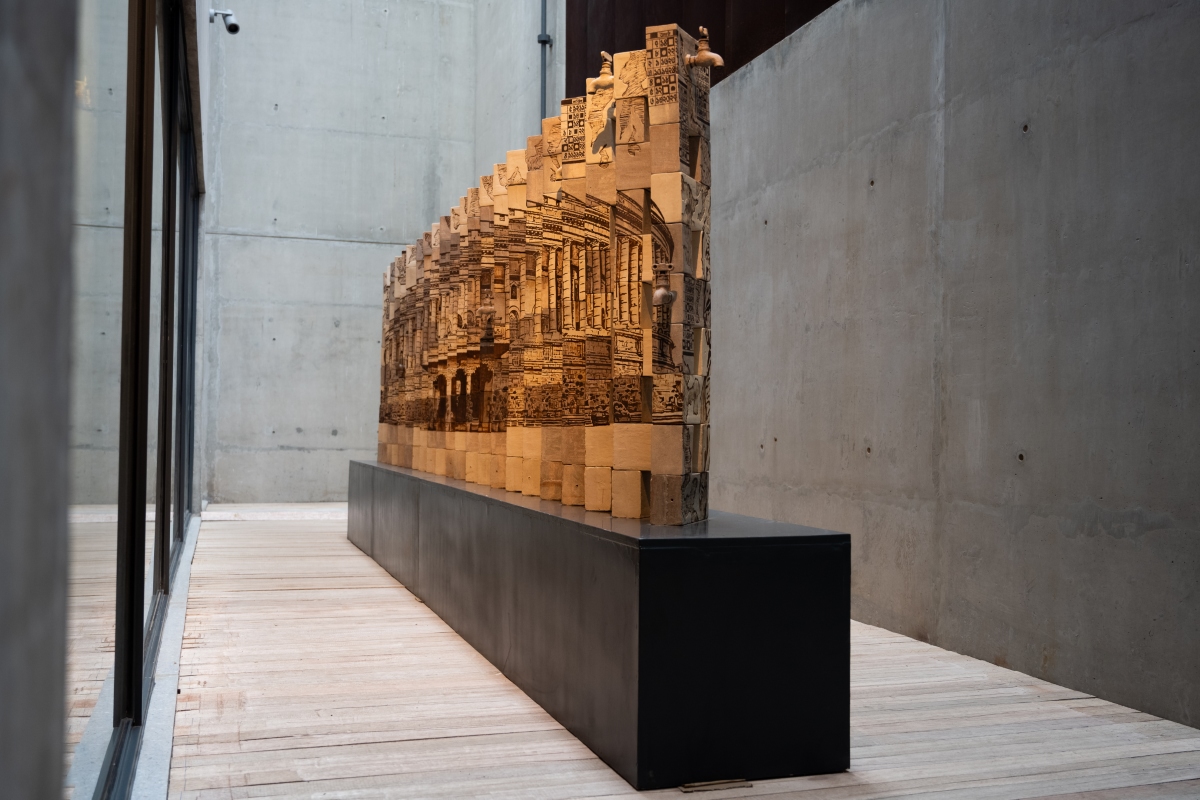
Common ground is where we stand.
Common ground is the base of the mass(es).
Common ground is our fate, our destiny.
The work comes from the belief that the earth is a register of our footsteps.
Asish Chowdhury has shaped or shifted clay collected from various sites of protest into the form of bricks and arranged them into a wall. The bricks hold their imprints, and bear witness. Drawing from his long-time work centered on common people’s voices, their sorrows, and their anger expressed as protest, the artist paints these social moments onto bricks that will carry the stories into the future. Images from the recent past are interspersed to create a series of ever-changeable fragments. These stories are a celebration of those who fought for us amidst the pain of daily life. The wall is a gigantic silent scream.
ASISH CHOWDHURY is a ceramics artist based in Kolkata, West Bengal. Using clay as a vehicle for interrogations of the complexities and harsh realities of modern life, he draws from national news of social upheaval and signs of protest to the ubiquitous presence of architecture to inform the shape of his narratives.
A graduate of Visva Bharati, Sriniketan in 2003, he now runs his own studio while also working as Ceramics Mentor at the Arts Acre Museum, Kolkata.
He has won many awards and had major solo shows at the India Habitat Center and several private galleries in New Delhi, in addition to participating in group shows. He also frequently attends workshops around the country, the longest of which was a 45-day International Ceramics Workshop in exchange program with Korean Ceramic Artists at Kalakshetra, Chennai.
He is currently immersed in a project based on the ideas of Borderland.
Awdhesh Tamrakar: A Land Of Silent Echos (Series)
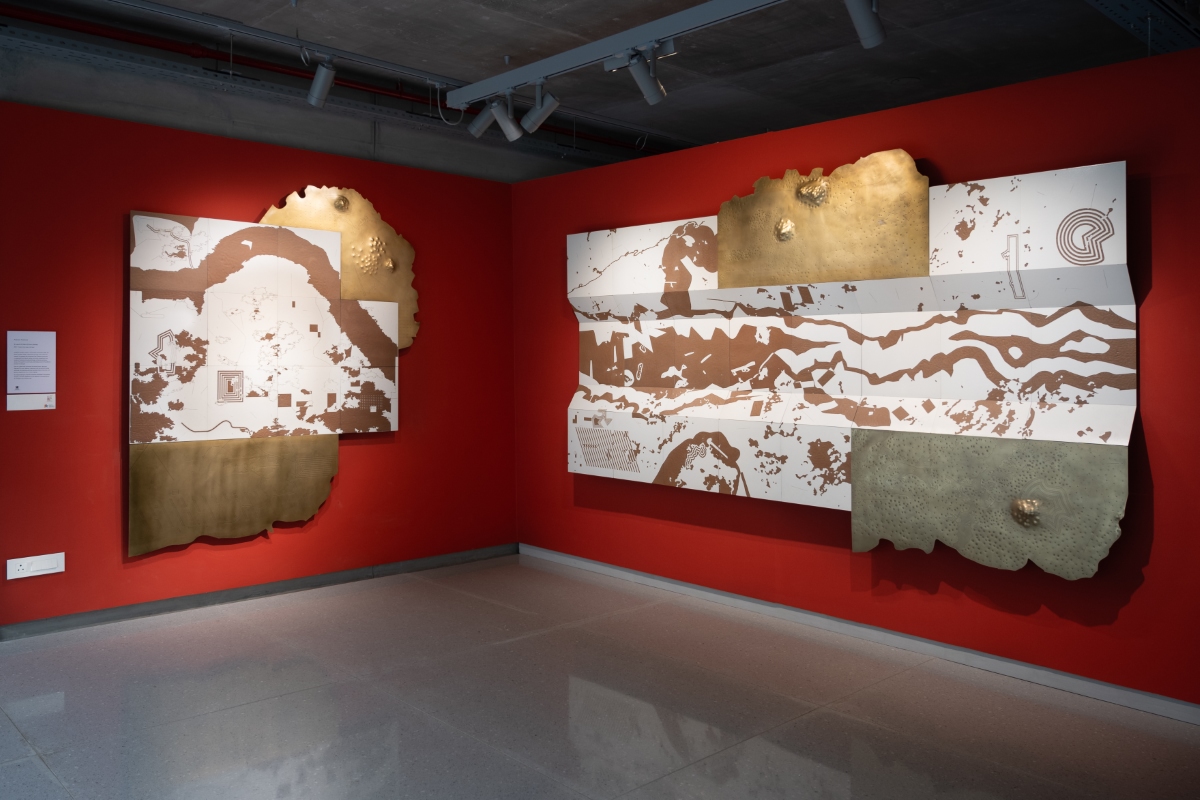
Awdhesh Tamrakar creates a visual history of Pancham Nagar, the artist’s ancestral village, a place that now lives only in story and memory. He presents the narratives of the Thathera community, a coppersmith and utensil-making community; speaking to loss, erosion of memory and cultural heritage, while also pursuing a revival of the spirit of a community inextricably bound to its craft and ancestral landscapes.
Each tile, gilded with hammered and etched brass, captures a fragment of a river’s essence, interwoven with remnants of diverse structures. His meticulous process translates history, memories, and personal experiences into a visual language.
An intense attempt to resurrect narratives embedded in the poetics of space, it is both a testament to the resilience of storytelling and an homage to the Thathera craft.
AWDHESH TAMRAKAR was born in Shahgarh, Madhya Pradesh in 1989. He completed his Bachelor and Master degree in Sculpture from the Faculty of Fine Arts, M.S. University Baroda, in 2013 and 2015 respectively. Tamrakar has been awarded a Gold Medal and Chinmoy Pramanik Memorial Award both from Faculty of Fine Art, Baroda in 2015, and Emerging Master Award by Sarjan Art Gallery, Baroda in 2014. Tamrakar’s solo exhibitions include Dūr-darāz at Shrine Empire Gallery, New Delhi in 2022, Muted Mathaar: Supported by The Raza Foundation at Triveni Art Gallery, New Delhi in 2021, and Unfastened Association, supported by SCZCC, Nagpur, at Faculty of Fine Arts, Baroda in 2016.
Recent group shows and projects include Art Mumbai 2023, Delhi Contemporary Art Week 2022-23, Thinking Matters, curated by Mario Dsouza, Baroda, 2020; Heads in the cloud, under Five Million Incidents, by Goethe Institut New Delhi and Kolkata,2020. Tamrakar was a Guest Faculty in the Department of Fine Arts, S.N.School of Arts and Communication, Central University, Hyderabad from 2018 to 2023. Awdhesh lives and works between Hyderabad and Baroda.
Birender Kumar Yadav: Re-Presented From The Traces
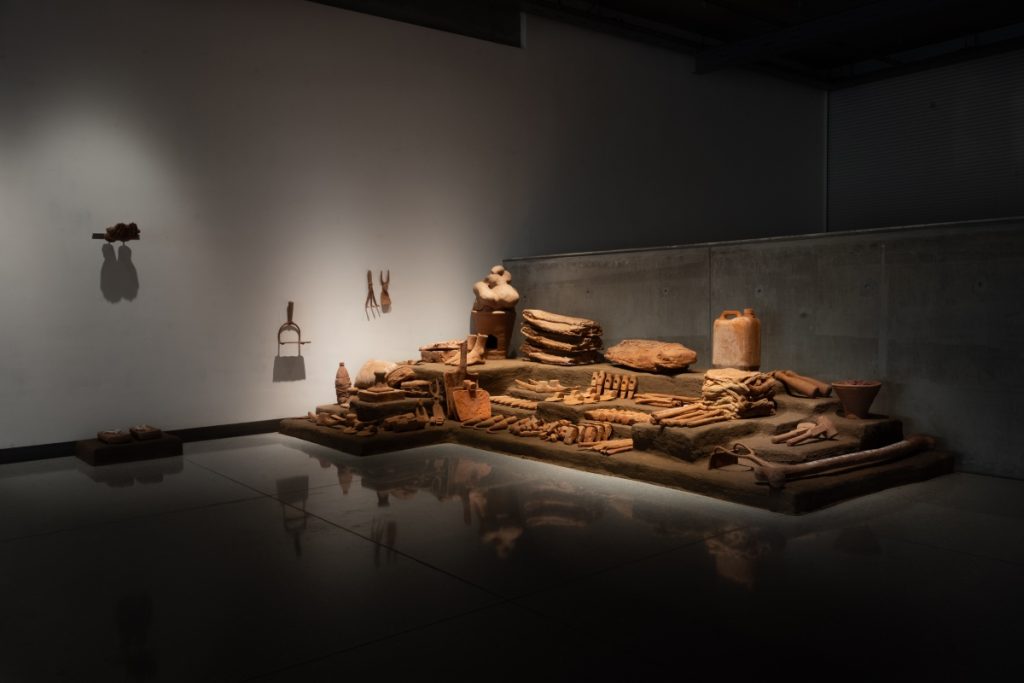
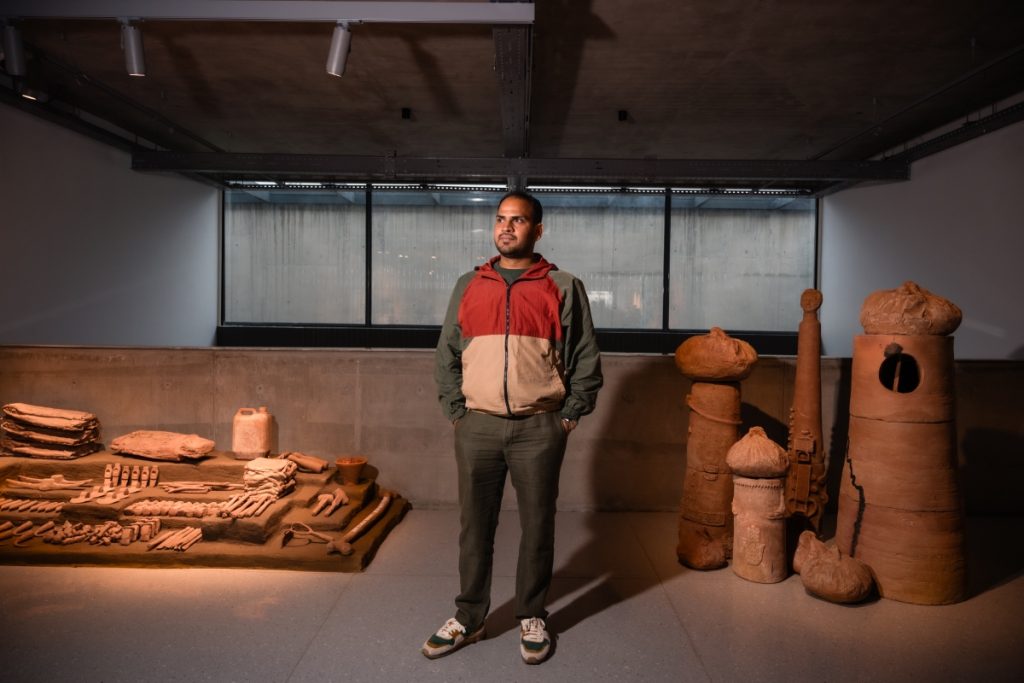
The project documents the lives of brick kiln workers in the city of Mirzapur, about sixty percent of whom are lower caste migrant seasonal workers. As migrant labour they work long hours and suffer malnutrition. Most brick kiln workers suffer broken ribs from the hard work. Children do not go to school. The season extends from November to June, after which their temporary homes are demolished. Over the years Birender Kumar Yadav has relayed their plight through media such as sculpture, photography, and installation.
In Re-Presented From The Traces, the artist has made casts of ordinary artifacts left behind after demolition, reframing them as sculptures. Through small gestures and everyday objects, his work carries a large emotional registry, yet he remains conscious of the gap between the objects and the lived experiences of the workers; conscious that the object’s emotional value lies in an original that no longer exists.
BIRENDER KUMAR YADAV is an Indian contemporary artist whose work is deeply rooted in his personal and cultural background. Coming from a family of ironworkers in Dhanbad, Birender’s early exposure to his father’s craft sparked his interest in art and craftsmanship. He embarked on a journey to study fine arts, earning his academic degrees from Banaras Hindu University and College of Arts, Delhi University.
Birender’s artistic endeavors have gained recognition both in India and internationally. Notably, his participation in exhibitions such as the @berlinbiennale has brought his unique artistic language to a global audience. Drawing inspiration from his upbringing in a mining area surrounded by a working-class culture, Yadav’s work eloquently captures the labor, life, pain, struggle, and beauty that characterize this particular social stratum. Through his art, he seeks to fuse traditional ironworking skills with academic knowledge, creating a visual dialogue that transcends boundaries and bridges disparate worlds. Birender lives and works in New Delhi, India.
The Chinnagama Project
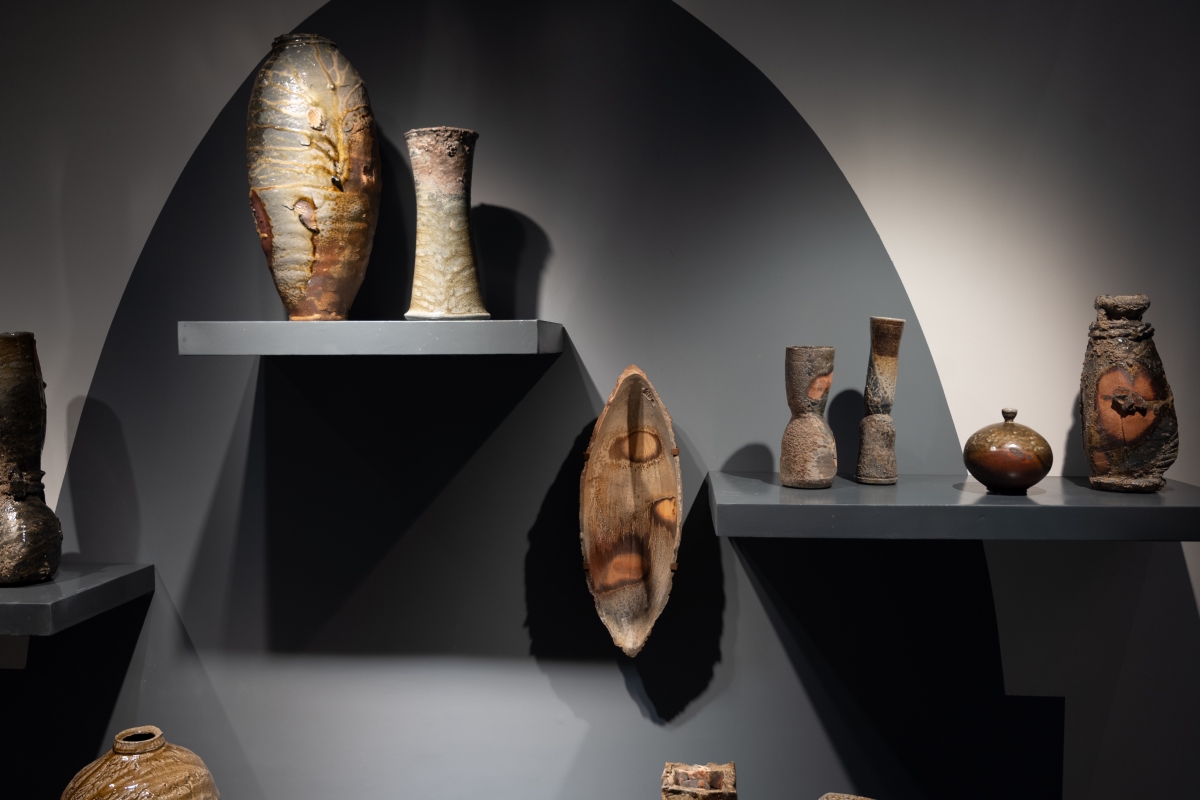
Anagama is a Japanese term referring to a ‘cave kiln’, in which pots are fired for days allowing wood ash to accumulate on the surface producing a very distinct and rich surface. The Chinnagama Project is an ongoing, seventeen-year-exploration of anagama firing in India which began in 2007 when Peter Thompson from Australia was invited by Ray Meeker to the Golden Bridge Pottery in Pondicherry. Peter and Ray built the first anagama in India.
The Chinnagama (‘Chinna’ in Tamil is small) was built in 2012 from the same bricks as the original anagama. As the kiln developed, so did the firing process. Jeff Shaprio, Jack Troy, Tim Rowan, Bruce Dehnert, Nick Schwartz and John Dix have contributed different approaches to its firing. Firing the Chinnagama is a cooperative effort between fifteen to twenty artists building on the knowledge from preceding groups.
The CHINNAGAMA PROJECT is an ongoing, seventeen-year-exploration of anagama firing in India which began in 2007 when Peter Thompson from Australia was invited to the Golden Bridge Pottery in Pondicherry. Peter and Ray Meeker of Golden Bridge Pottery built an anagama, the first in India.
The Chinnagama was rebuilt from the same brick when the larger anagama was dismantled in 2012. As the kiln developed, so did the firing process. Different approaches. Jeff Shapprio, Jack Troy, Tim Rowan, Bruce Dhenert, Nick Schwartz of the USA and John Dix of Japan. Each anagama firing experience is a cooperative effort between fifteen to twenty artists building on the knowledge gleaned from preceding groups.
Copper Sounds: Sequenced Ceramics
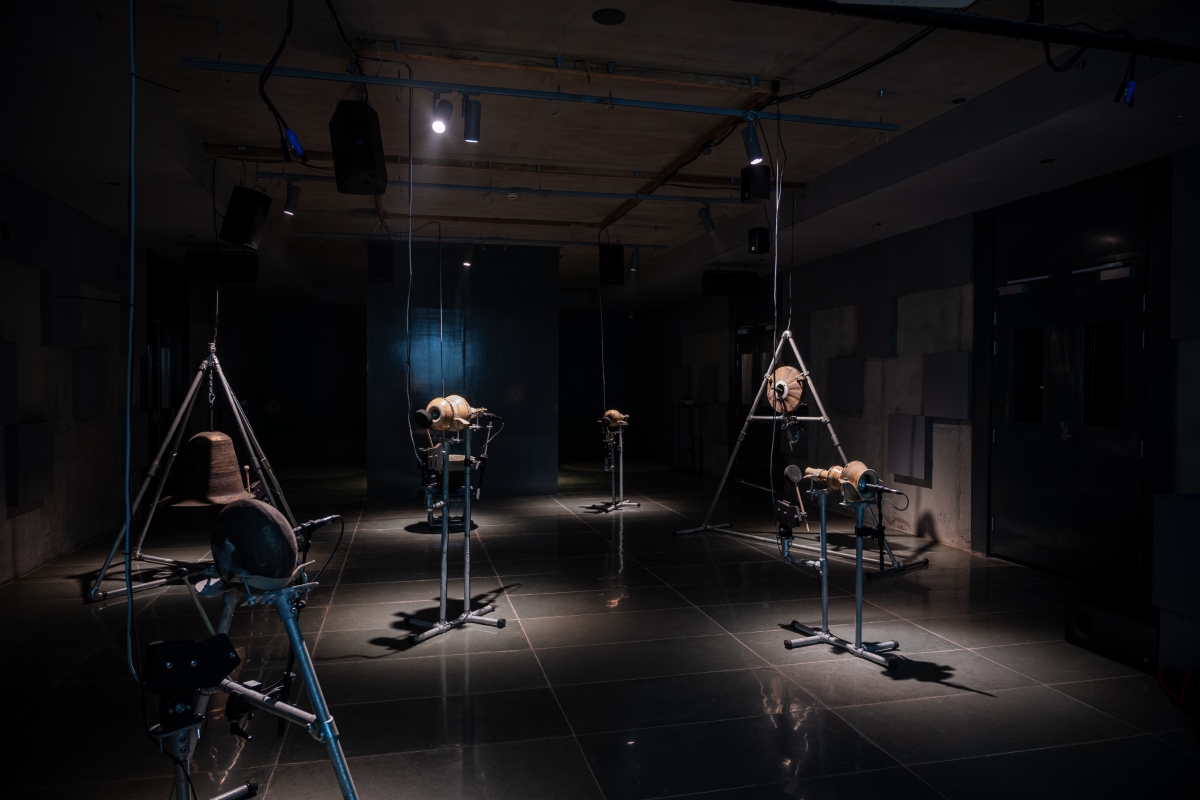
Sequenced Ceramics is an immersive ceramic sound installation inspired by traditional bells, singing bowls and sculptural clay instruments such as the ghatam.
Experiments with different clays, forms, and scales allowed Copper Sounds to gain a deeper understanding of the specific acoustic and resonant properties of ceramics. The final sculptures exhibit a range of traditional clay making techniques and were sculpted with both visual and sonic aesthetics in mind. They form an intimate installation activated by a custom-made sequencer and mechanical beaters. The minimalist hypnotic compositions invite the viewer to contemplate the relationship between form and sound.
Sequenced Ceramics was developed in collaboration with Chris Ingram, Milly Hardy and Thomas Blackstock with the help of funding from Help Musicians UK. This installation was shown at British Ceramics Biennial’s headline exhibition Award in 2023.
This project is part of the International Exchange Programme in partnership with the British Ceramics Biennial and is kindly supported by the British Council, British Ceramics Biennial and Henry Moore Foundation.
COPPER SOUNDS (ISAAC STACEY AND SONNY LEE LIGHTFOOT) is an artist duo who use traditional and contemporary ceramic processes to explore the physical and visual nature of sound. Like clay, they see sound as a malleable material, and manipulate it through designing, making and often performing with unique sonic objects.
Their process is about experimentation and the unknown, trying things out and always thinking directly about how the object and the sound affect one another. The objects they make tell the story of their process and act as markers of their journey through sound.
Eliza Au: Stepwell
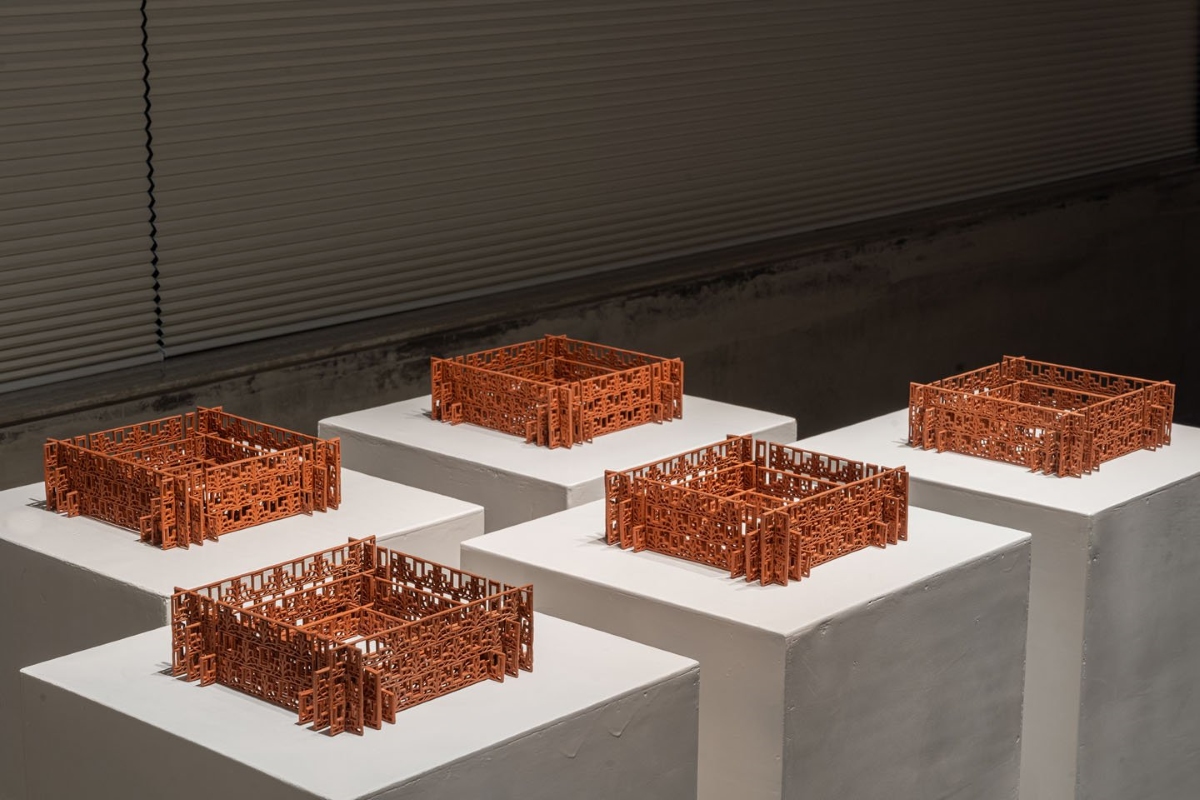
Eliza Au is interested in how pattern and ornament operate in sacred architecture. Her project investigates the four-sided symmetry of a stepwell with its alternating steps leading down to the water. By holding water, the stepwell acts as life-giving architecture. A meditative rhythm emerges through the repetition of the arabesque pattern in the two-dimensional planes in her forms. A sense of lightness and effortlessness is created by the regularity of the perforated planes; and the objects get divorced from mass and form as negative space defines the work as much as positive space.
Another form that influences her is the traditional Indian jali, a perforated stone or latticed screen, common in Indo-Islamic architecture. These screens filter harsh light and help ventilate the interior of the building. By combining the jali with the stepwell form, a normally heavy, immovable architecture becomes light and airy, alluding to these spaces as practical but also spiritual places.
ELIZA AU is originally from Vancouver, B.C. in Canada. She received her BFA from the Nova Scotia College of Art and Design and her MFA from the New York State College of Ceramics at Alfred University. In 2020, she received an Award of Excellence during the Chrysalis Competition held by the James Renwick Alliance. Her work is in several permanent collections including the Everson Museum of Art and the Montreal Museum of Fine Arts. Au is currently based in Texas where she is an Assistant Professor of Ceramics at the University of North Texas.
Hayley Coulthard and Rona Rubuntja: Nhanha Arna-Urrknga Nurnaka Pmara-Rinya Rinya / This Clay Belongs To Our Country
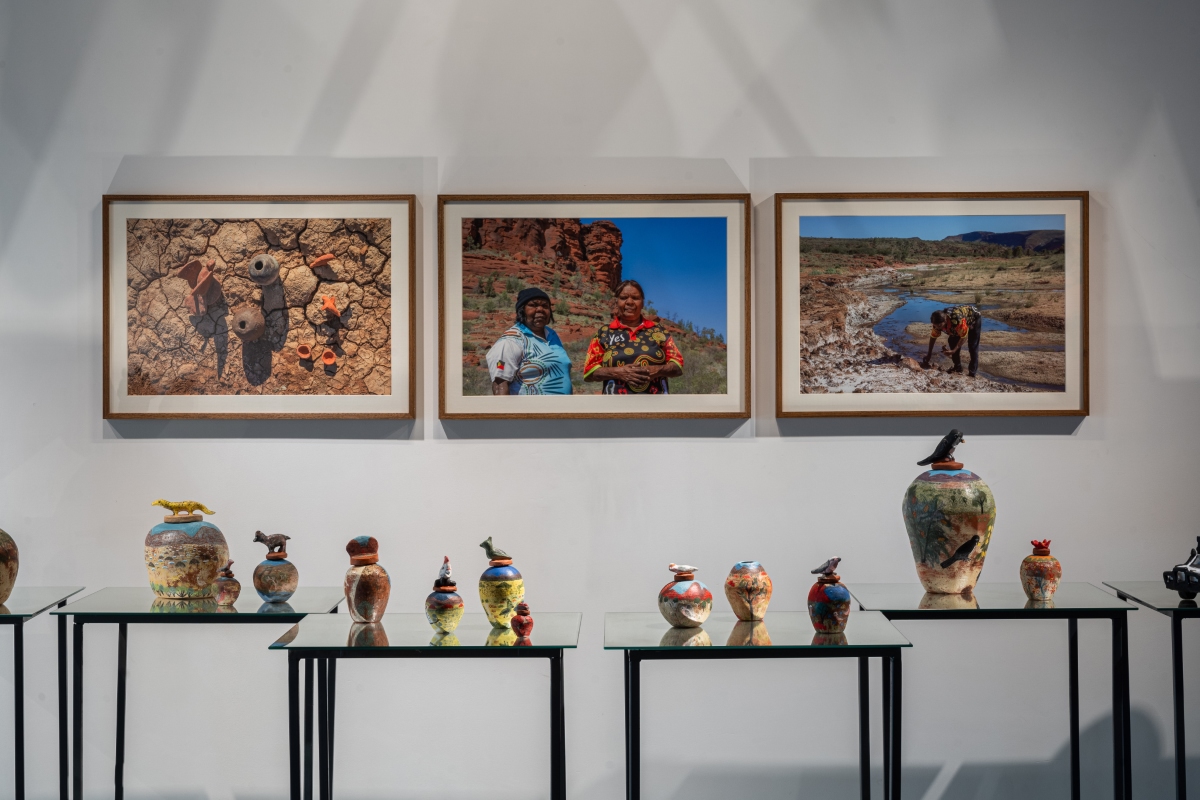
Nhanha Arna-Urrknga Nurnaka Pmara-rinya rinya (This Clay Belongs to Our Country) is a process driven body of work through which the Hermannsburg potters locate, extract, and process clay from their traditional lands on Western Aranda Country to create ceramic work. In Western Aranda culture, the concept of ‘Country’ refers not just to nations, or the physical landscape, but also to the living one – the plants, animals, people and the ways in which they interrelate. It is a place of belonging and a way of being. The term contains complex ideas about law, custom, language, spiritual belief, cultural practice, family and identity. The bringing of clay from Western Aranda lands to Delhi, India, is itself a deeply symbolic gesture, transporting ‘Country’ and all that is embedded within it – culture, custom, identity, memory, understanding – to be generously shared in a new context.
The HERMANNSBURG POTTERS are a dedicated group of Western Aranda (Australian Aboriginal) artists creating vibrant handmade ceramic pots that express their collective and individually lived experiences in their distinct Country. The Potters practice from their studio in the small community of Ntaria/Hermannsburg, in the remote central desert region of Australia.
Through ceramics, the Potters sculpt and paint their visual histories and contemporary settings, speaking to Western Aranda cultural beliefs and traditions and the present-day experiences of Indigenous peoples in Australia.
Hayley Coulthard is an artist, art worker and current Chair of Hermannsburg Potters. She has been working with clay for 15 years and has exhibited widely across Australia and internationally. Rona Rubuntja is a founding member of Hermannsburg Potters where she has practiced for over 30 years. Rona is deaf and uses art to share stories from her life. She is renowned for her vibrant, humorous work and technical skill.
Kushala Vora: By Heart
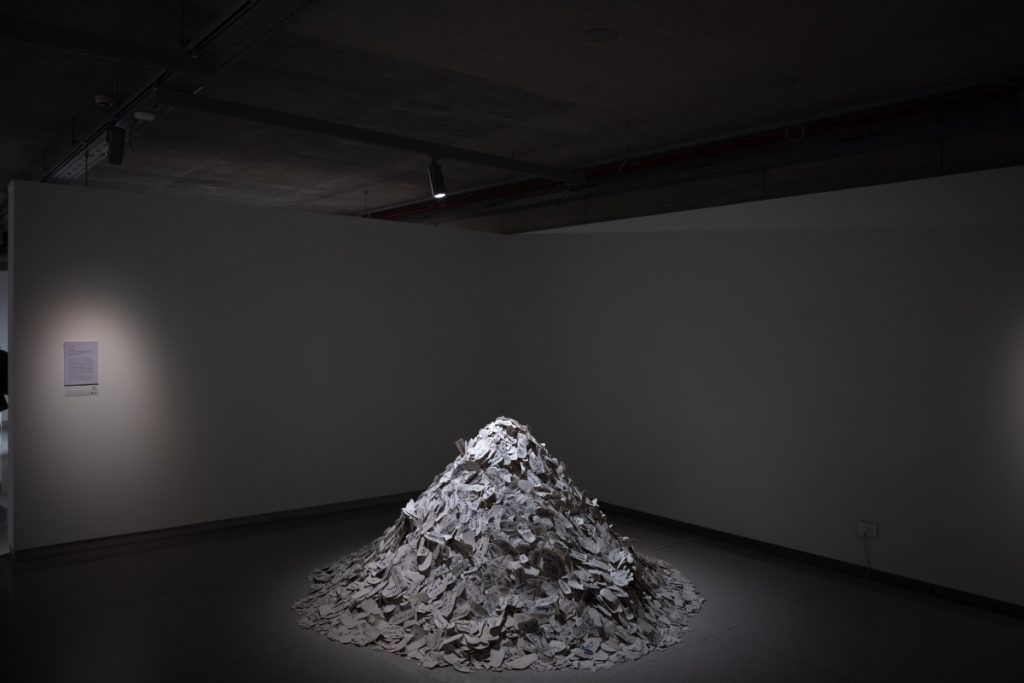
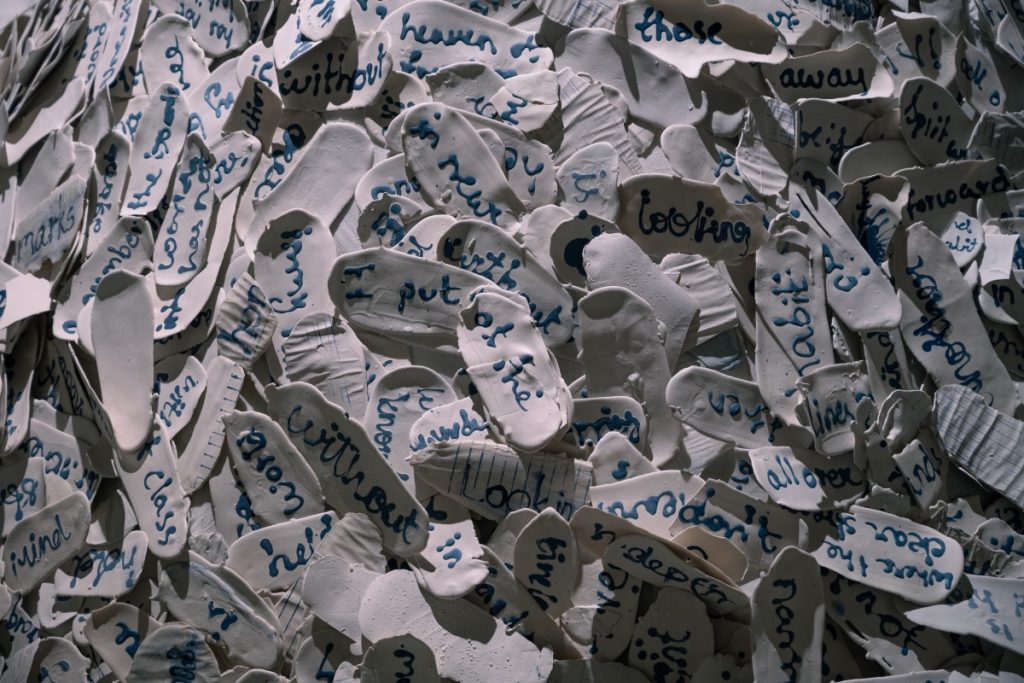
With each beat and breath, the body is imprinted upon with innumerable social conditionings. Kushala Vora grew up in the hill station of Panchgani. In the shadow of multiple empires that came and went and continue to exist, she subconsciously imbibed hidebound systems of hierarchy, fear and power and colonial attitudes. To break the conditioning associated with her own education, she revisits a poem Where the mind is without fear written by Nobel laureate Rabindranath Tagore in anticipation of freedom, 46 years before independence. Chiseled at the entrance of her high school, Kushala would see the poem everyday while living a personal reality that was far from it. She wrote a poem in response, questioning our ways and asking us to imagine another future, pointing again to Tagore’s dream.
By Heart is created from the accumulated gesture of writing and imprinting both Tagore’s and her poem onto porcelain. By actively bringing into her conscious memory the visual markers and residues of colonial power, she seeks to unmake sets of micro-habits.
KUSHALA VORA is a dreamer, community organizer and an interdisciplinary artist based in Panchgani, India and Chicago, USA. In and through her practice she focuses on loosening the exertion of power on oneself, another and the landscape that we reside with. Kushala is one of Chicago’s Newcity 2023 Breakout Artists. She has recently been an artist in residence at The Hyde Park Art Center, Skowhegan School of Painting and Drawing, and Anderson Ranch Art Center. Kushala received a MFA from The School of the Art Institute of Chicago. She holds a post-graduate diploma in Modern and Contemporary Indian Art History and Curatorial Studies from Dr. Bhau Daji Lad Museum in Mumbai, India. She is the co-founder of Atmo – a reading + praxis forum, and is an active contributor of Spaceshift Collective and Floating Museum.
Creative Dignity: Lost And Found
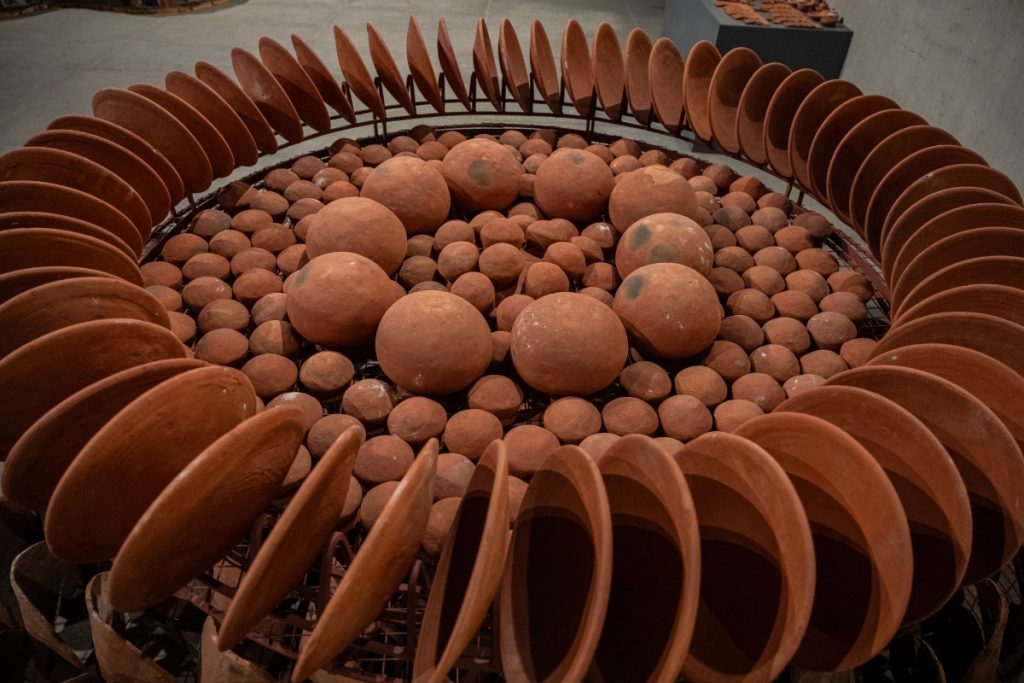
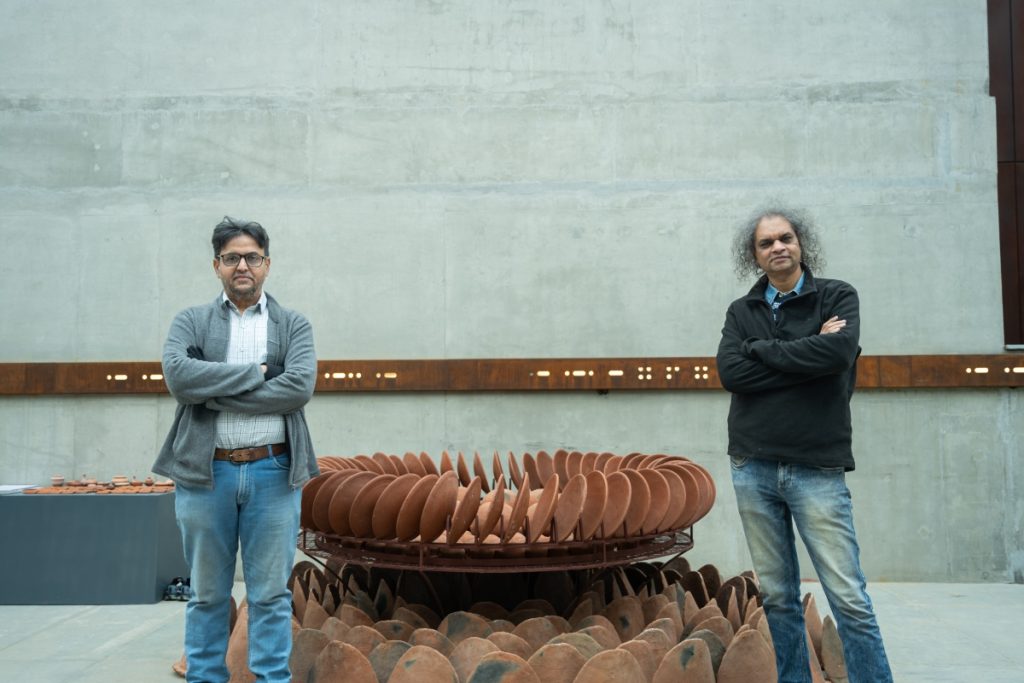
Reuniting the notions of ‘art and craft’ in their original, intertwined form is crucial. Lost and Found, is analogous to a theme often visited in Indian Cinema – that of two brothers separated, and then reunited.
It transcends contemporary differentiation between the arts and crafts in an effort to reconnect with one’s roots. Early art forms mark pivotal human evolution episodes, and visiting pottery clusters in Warak (Maharashtra) and Kutch (Gujarat) aims to link our story back to those origins.
Engaging with artists from these clusters affected by natural disasters, reveal their resilience and positive energy. This installation is an expression of that remarkable emergence from adversity. Lost and Found is one part of an ongoing process of collaboration between potters, Kumbhar Ismailbhai Hussein, and Kumbhar Alimamad Dhavad from Lodai, Kutch, Santosh and Rakhi Warekar from Indapur, Maharashtra, Raju Sutar and Rajesh Kulkarni who led the experiments and curation for this project.
CREATIVE DIGNITY (Lota Ismailbhai Husen, Kumbhar Alimamad Dhavad, Santosh and Rakhi Warekar with Curators Raju Sutar, Rajesh Kulkarni) is an innovative collaborative network that brings together various stakeholders within the Indian handmade sector to envision ”A world where artisans have agency to thrive with dignity.” The Indian handmade sector is rooted in natural materials and inclusivity, and traditional craftsmen can address climate change at the grassroots. The “Lost and Found” project curated by Rajesh Kulkarni and Raju Sutar falls under their Craft x Climate initiative that positions craft practices as models to mitigate the climate crisis. The project works with pottery clusters in Indapur (Maharashtra) and potters in the Kutch district by experimenting with clay mixes, firing techniques, and new forms. The aim is to create an art installation with a contemporary appearance rooted in strong traditional beliefs. The potters, Lota Ismailbhai Husen, and Kumbhar Alimamad Dhavad in Kutch, and Santosh and Rakhi Warekar in the Warak Cluster, experienced a revival post natural disasters. Local resources and skills facilitated a swift rehabilitation demonstrating the resilience of creative producers and offering a potential path forward for the future.
Om Prakash Galav: Shunya
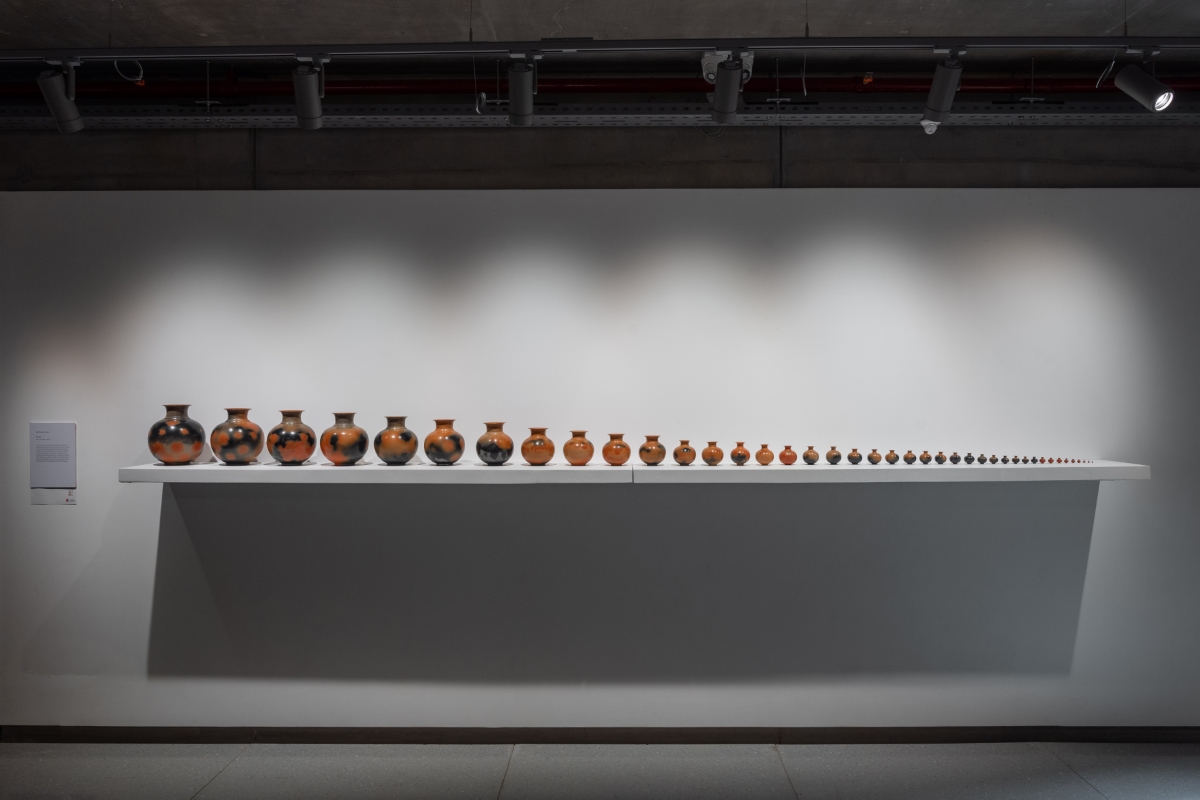
The lota is a common and culturally significant container form, traditionally intertwined with daily life and rituals in India. Through his unique working style employing meticulous burnishing and special reduction firing techniques, Om Prakash Galav achieves a diverse colour palette in his lota forms. The result is a series of aesthetically pleasing pieces that form a unified and nuanced line of expression; the deliberate variation in sizes, from large to miniature, encapsulates and mirrors our spiritual journey, from the outer towards the inner progressing to Shunyata, nothingness.
OM PRAKASH GALAV, a resident of Ramgarh district Alwar, Rajasthan, hails from a long line of ancestral potters, with more than 15 generations dedicated to advancing this craft. He possesses a profound passion for clay work and consistently strives for innovation. Om Prakash Galav has left an indelible mark in the world of clay art, holding the record for crafting the smallest terracotta artifacts alongside creating impressive giant pieces. His achievements extend to receiving both National and International awards for his exceptional work in terracotta pottery.
Prithwiraj Mali: Home For The Homeless II
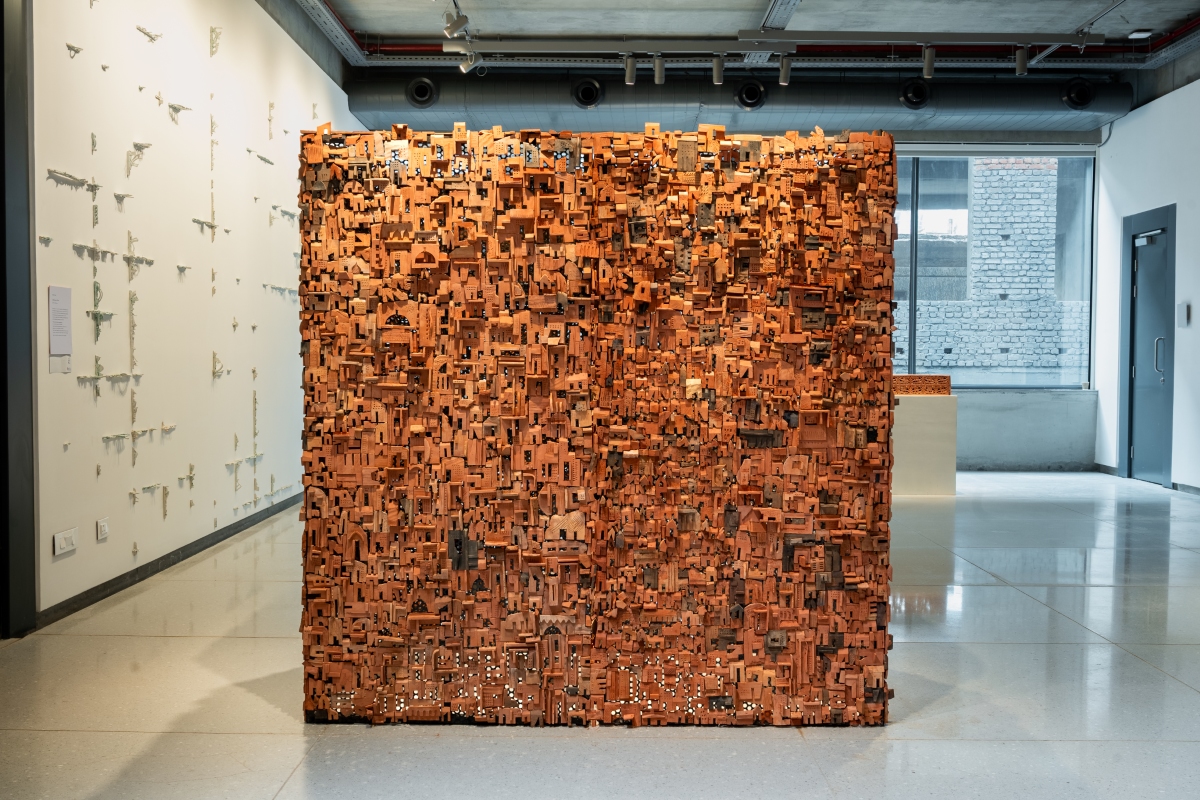
Being part of the same social structure and geography does not automatically imply being part of a community. Prithviraj Mali believes the whole world is a family and humanity is our ultimate responsibility; which means that everyone inevitably has a role to play.
As an artist and human being he is nourished by the idea that we are connected through feelings of brotherhood, responsibility and sensitivity, without any limitations. We need home projects, not housing projects. He is moved by honeybee colonies where migrations occur regularly and each new hive is a combined effort to contain larvae, stores of honey and pollen.
As the pressures of rising populations, environmental damage and political turmoil mount, forced migration everywhere has become imminent. Housing is an urgent need for marginalized people driven away from their homelands. Mali’s question: “In our own country, are we successful in the goal of providing shelter and security to all, or have we failed?” remains a question for each of us.
PRITHWIRAJ MALI was born in 1978 in Bargan near Sundarban, West Bengal. He was brought up in a rural environment where he completed his primary education, during which the regional socio-cultural values had a deep impact on him. He was also deeply influenced by the socialist ideologies arising from the findings of the natural disasters in the region, and also the notches of partition and miserable migrations of India.
He has studied at the Government College, Calcutta and the Faculty of Fine Arts, Maharaja Sayajirao University of Baroda i. While pursuing post-graduation at Baroda, his artwork reflected the regional sentiments and socio-political aspects of Bengal. He successfully portrayed the serious concerns of society with humor.
In 2006, he had the opportunity to work with Hervey Hood at the Berllanderi Sculpture Workshop in South Wales, United Kingdom. He eventually moved to Vadodara as a practicing artist, and spent fifteen years as an academic in several architectural institutions and also participated in national and international art exhibitions. This exposure provided a new dimension and language to his ideas, which is reflected in his artwork. He lives and works in Vadodara as a freelance artist.
Roy Maayan & Erez Maayan: Play With Me
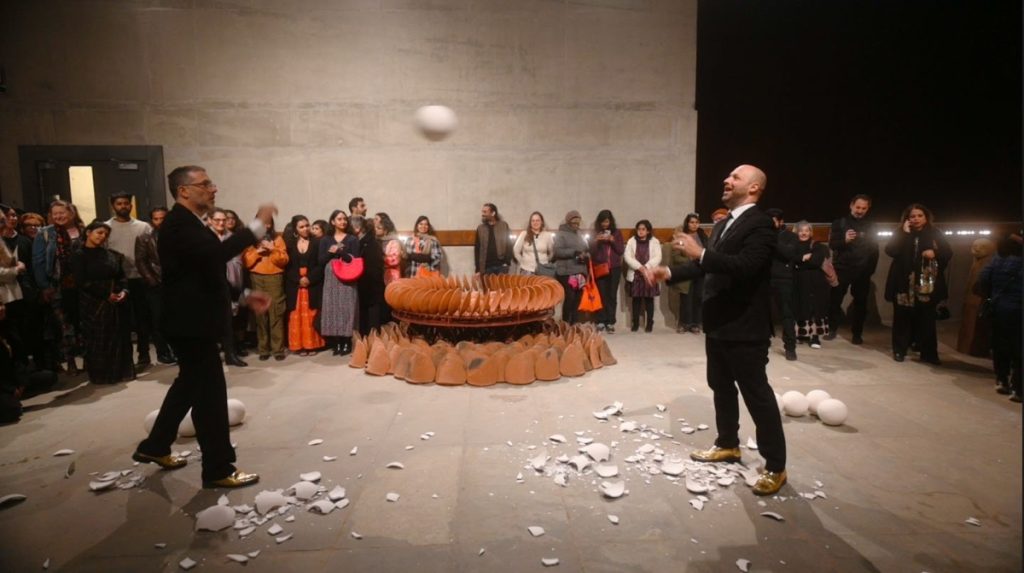
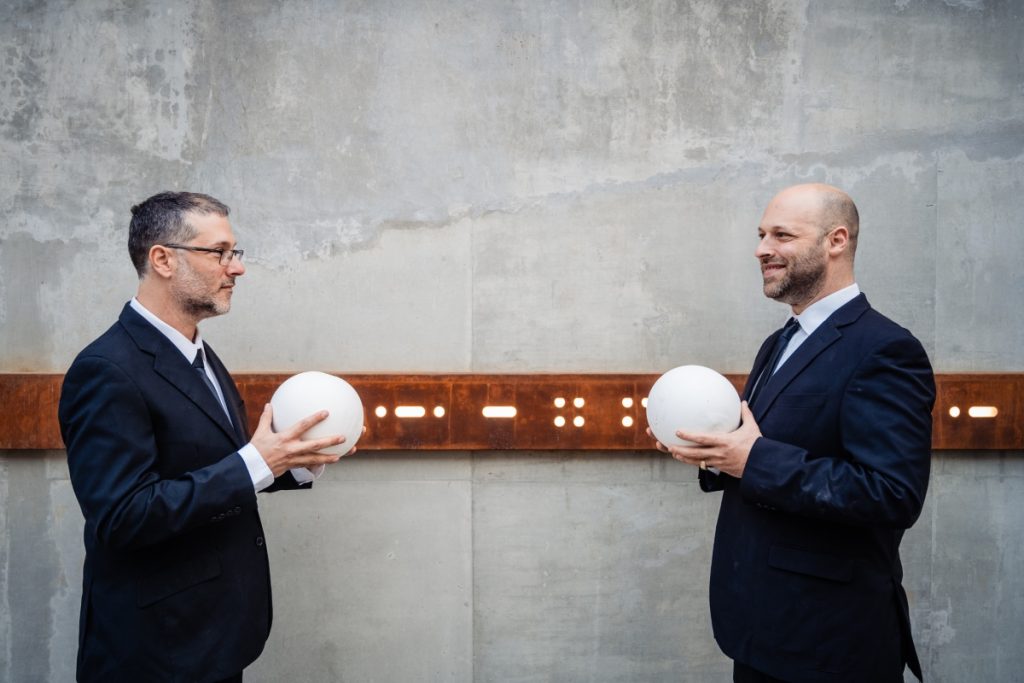
Play with Me is a ceramic-performance, an action-installation and a video artwork. The artist-brothers Roy Maayan (ceramics artist) and Erez Maayan (performance artist) play catch with ten ceramics balls. As they engage in the playful action, every once in a while a ball drops and breaks. The remains of the performance constitute a memory, an action-installation, embodying the playfulness, fragility and brotherhood. The piece is changing throughout the artistic action: at first the balls are displayed intact, followed by the live action, which transforms the installation. The whole process is documented and presented alongside the installation for viewers to see and imagine.
Brother-artists ROY MAAYAN (ceramics) & EREZ MAAYAN (performance) have been collaborating for the past 20 years. Their field of interest is in cultural and material relations, inter-medial encounters and the interaction with audiences. Their aim is to bridge the gap between high and low (art/materials), and between the performative act of art-making and the artistic object itself.
Their work has been presented in numerous exhibitions and events, in Museums, galleries and biennales around the world (Israel, England, France, Latvia, Romania, Belgium, Cote d’Ivoire, Jordan, South Korea, Senegal, Azerbaijan, Croatia, USA, Switzerland and many more).
Roy holds an M.A. in the arts from Tel Aviv University and a BFA in the department of ceramic design from Bezalel Academy, Jerusalem. Erez has a Ph.D. in Performance Studies and an M.Sc. and B.Sc. in Biotechnology, all from Tel-Aviv University. Erez is the artistic director of Tmuna Theater in Tel-Aviv & Roy has an active studio in Tel-Aviv. Both teach in academies and professional art schools and hold seminars, symposiums and lectures on various subjects.
Shraddha Joshi & Ross Andrews: The Divine Plan
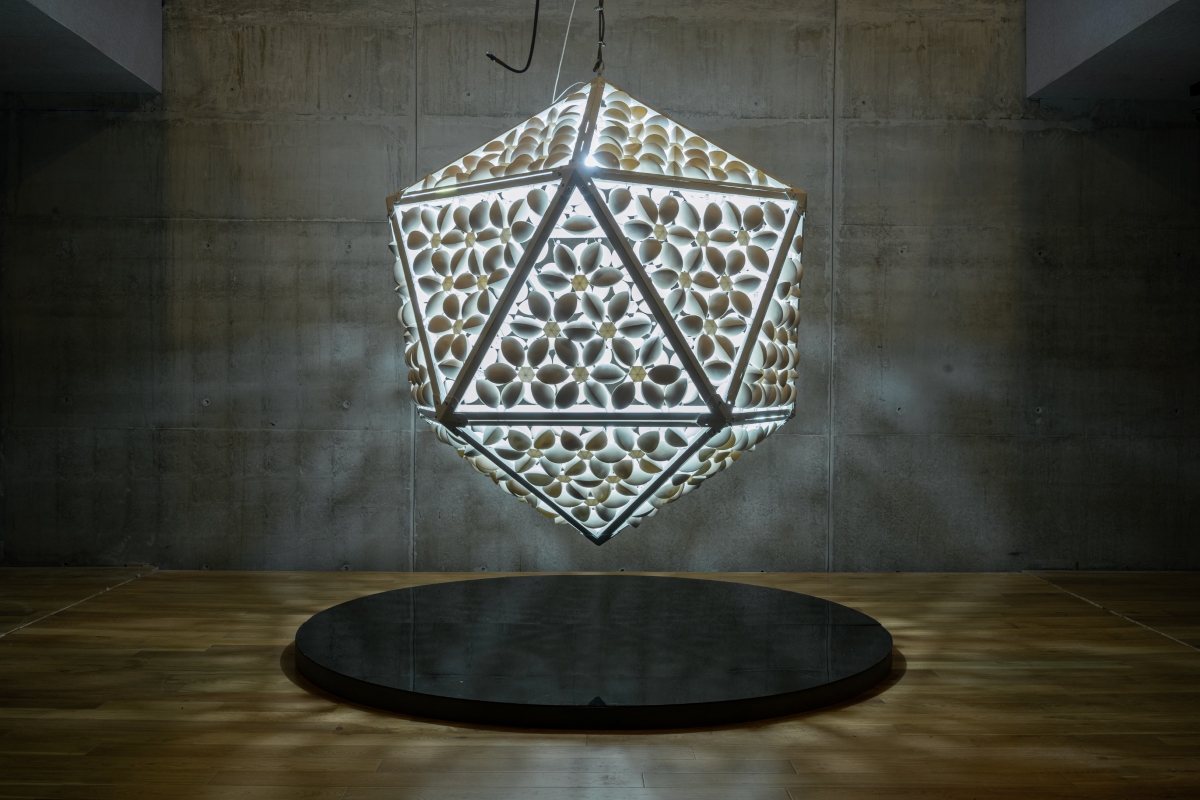
In geometry, a Platonic solid is a convex, regular polyhedron in three-dimensional space. Referred to as sacred geometry, Plato associated these forms with earth, water, fire, air, and ether. In their installation Divine Plan, the artists use interconnected icosahedrons (a water element denoting human emotions) to focus on co-existence and multiple realities, the interlinked multiplicity reflecting one of the central ideas of a common ground.
The 1000 interconnected slip cast porcelain pods re-invents century old techniques of slip casting production to create an ambitious architectural exploration. The emitted glow of the experimental and multisensorial installation allows an entry into a liminal zone where mind, body and soul can engage in self-reflection. and an open-ended, fundamental existential question of the “Divine Plan”.
SHRADDHA JOSHI & ROSS ANDREWS are ceramic artists who have both graduated from Cardiff School of Art and Design in South Wales.
Shraddha grew up amidst the rich cultural heritage of India absorbing a vivid spectrum of ideas around life events. She has always been curious, and has questioned the fundamental existential disposition as to why we as humans should value our place within the world. Her understanding of geometry and the relationship between pattern and form is truly compelling. To her, one small element used in repetitive arrangements to become something greater than the sum of its parts, is fascinating.
Ross Andrews’ work combines mould-making, slip-casting, sculptural hand-building and digital processes, such as 3D printing, to produce large vessels or ornamental pieces of sculpture. An attraction to architecture inspires Ross’s work – the built environment – as well as material luxury or things of ceremony and ritual. This attraction could be explained by being a gay artist and having a queer or ‘camp’ aesthetic. Although minimal in colour, his work is often either over-embellished or highly textured with the feeling of ‘more is more’.
Yulia Repina: Self Portrait. Fears
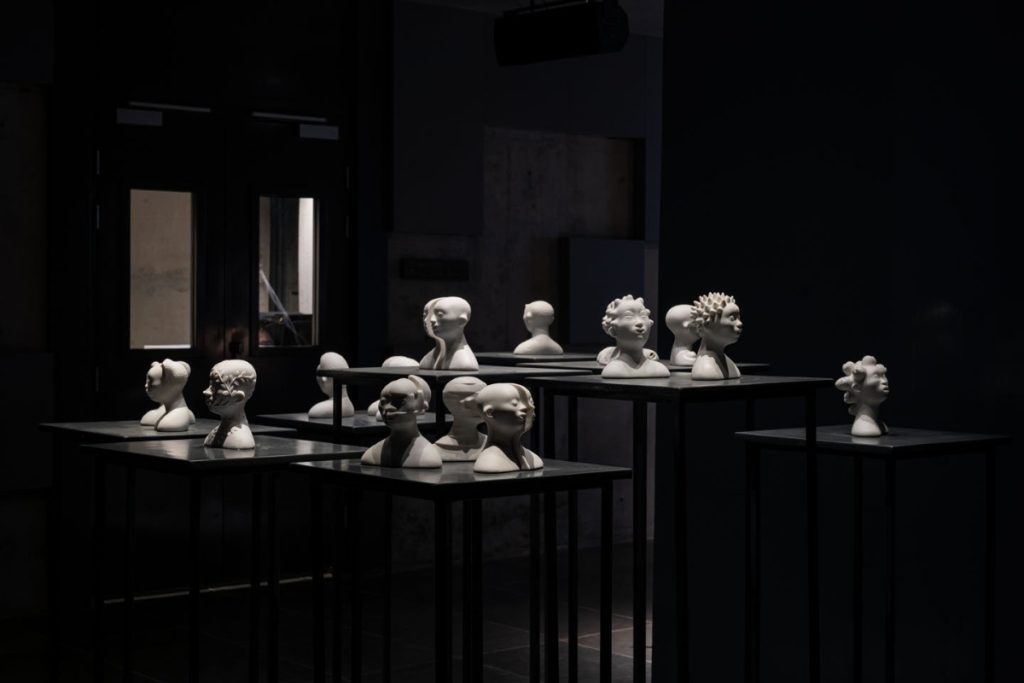
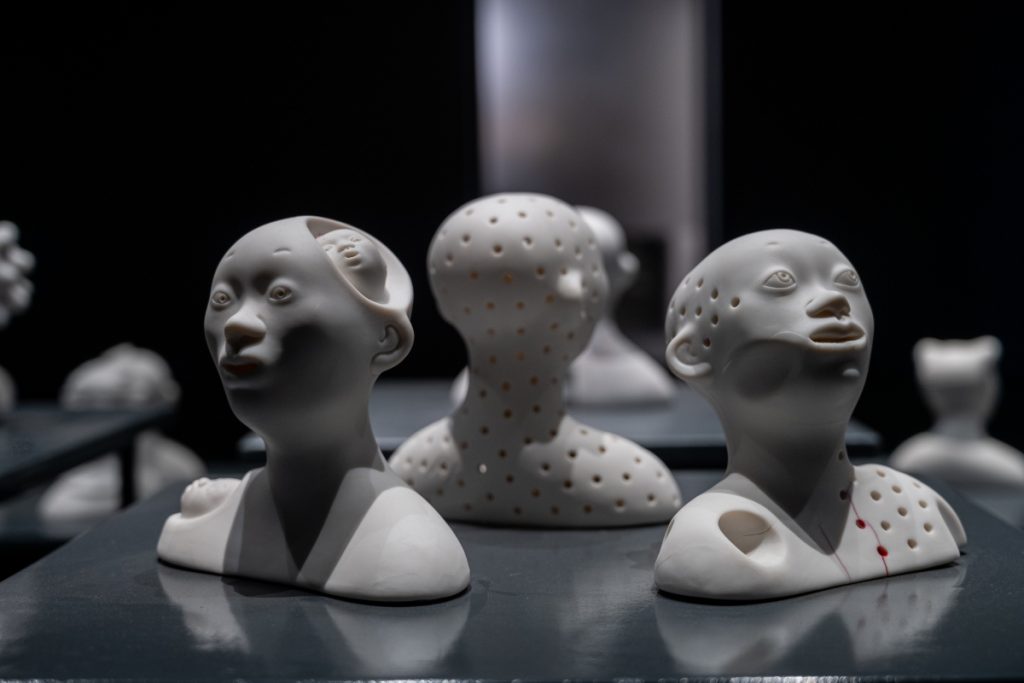
Yulia Repina confronts her fears, examining them from different perspectives through this body of work. The object placed within a virtual reality world provides a delicate balance between the tangible and the ephemeral. Embedded in the work is the contradictory duality of each character, representing the juxtaposition of strength and weakness, hidden and visible, rational and emotional.
The choice of delicate porcelain is intentional. It reflects the unpredictable nature of fears. The cracks from the high firing, filled with red pigment, add a final touch that brings the cold white porcelain to life, creating an impression of vitality and bleeding.Virtual reality often complements and enhances experiences.
Viewed through the VR space, the objects grow in size and multiply just like fears do. This interaction blurs the boundaries between the object and virtual reality, creating a unique and multi-dimensional and thought-provoking experience.
YULIA REPINA, a ceramics graduate from the Academy of Art in St. Petersburg, Russia, has been based in Munich, Germany, since 2012. Alongside her career as a studio artist, she leads a design team at the IT company JetBrains. A member of IAC since 2017, Yulia boasts over two decades of international experience, participating in exhibitions, symposiums, art residencies, and ceramics festivals across the globe, including China, Japan, Thailand, Korea, France, Italy, and more. Her recent endeavors include artistic residencies at La Meridiana (2021), Faenza ACC (2021), Guldagergaard (2022), and Kecskemét International Ceramics Studio (2023).
Yulia collaborated with a group of coders, designers, and tech enthusiasts from JetBrains – a software vendor specializing in creating intelligent development tools. The group is exploring augmented reality (AR), virtual reality (VR), mixed reality (MR), and extended reality (XR). Together, they’ve created an XR project to be showcased at the Triennale.
Contact
info@indianceramicstriennale.com


